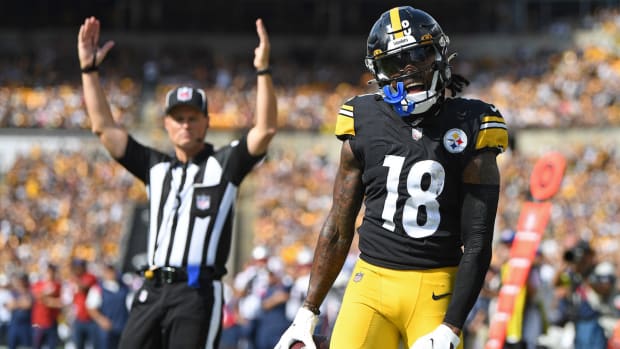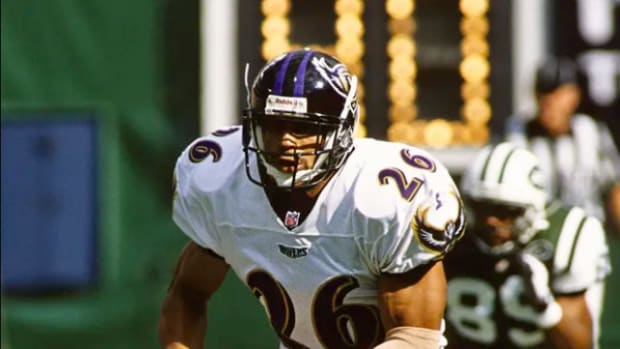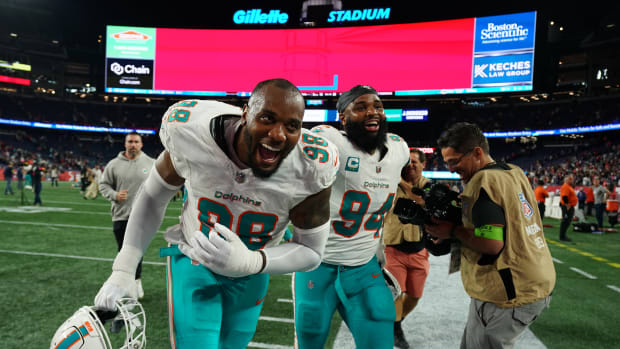FSU’s Brian Burns Has Studied Up and Bulked Up in Preparation for the NFL Draft
Brian Burns doesn’t pay attention to NFLmockdrafts and he’s a better man for it. But sometimes a friend or relative will send him a link to a newly published mock that predicts he’ll be drafted No. 4 to the Raiders. Then another that has him being picked 16th by Carolina. Or 22nd by Baltimore.
“I have noticed I’m all over the place,” Burns says. “There’s really no range for me. It goes from the highest at 4 to 26 or 31 or wherever. It’s all a blessing at the end of the day to be in the first-round talk. At the end of the day it’s all good.”
The 6' 5", now-253-pound player is one of the longest, most explosive edge rushers in this year’s NFL draft, and his athleticism leaps off the tape. In college, Burns’s game was all speed—when he entered FSU he weighed about 215 pounds, and he played around 230, which is 23 pounds lighter than he is now (don’t worry, details on his weight-gain diet are below). Burns has an incredibly high football IQ, and he explains his position and moves more like a coach than a 20-year-old draft prospect.
But Florida State has languished in the doldrums of college football the last two seasons, an unfamiliar spot for the Seminoles. And it’s possible that the team’s subpar performance has prevented its star edge rusher, who had 10 sacks and three forced fumbles last year for the 5–7 team, from getting attention.
Burns has to be one of the most well-prepared players ready to go to the next level in this draft. Listen to him explain his go-to pass-rush move—the inside spin:
“I line up about 2-3 yards outside the tackle, and my aiming point is like three yards behind him. I cock it a little bit so I’m not going vertically down the field, I’m coming more at an angle toward him. Coming off the ball, of course you have to have a good get-off, I give him a little stutter, jab outside, I use my inside arm to chop both of his hands, and once you get the inside hand, it’s really over because he can’t really recover from that.
“Once you chop both his arms with your inside hand, you spin around and you use your opposite hand to really clear yourself. You want to hit an area somewhere around the liver, his midsection of his back. You don’t want to go too high or too low but you definitely want to get in that area where you can throw yourself through.”
He learned from former FSU defensive end and current Broncos DE DeMarcus Walker how to study in the film room, and Brad Lawing, his former position coach at FSU, taught him all the techniques and jargon.
“He was very inquisitive,” says Lawing, now the defensive line coach at Georgia State. “Some of those guys when they get through the meeting, they can’t get out of there quick enough. He was a guy who would stick around and watch some extra tape.”
In his first two seasons at FSU, Burns played standing up and in space. His 2017 effort against Clemson—four-and-a-half tackles for loss, two sacks, two forced fumbles and one fumble recovery—is probably his best game on tape, setting the tone on the second defensive series and rolling after that. Last season, Florida State had him play more 4–3 defensive end with his hand in the dirt, and he turned that into a conference-leading 0.83 sacks per game average.
Burns, who ran a 4.53-second 40 at last month’s combine at 23 pounds heavier than his playing weight, would regularly be used as a spy against some of the ACC’s more mobile quarterbacks because of his speed. And when he’d rush the quarterback off the line, he’d maneuver his 34-inch-long arms into the outside number of the offensive tackle before flipping his hips to get into the backfield.
But Lawing said that Burns’s mind game was better than most players at his position; Burns understands what his opponent expects, and in return he’ll do something different.
“He learned how to set up offensive linemen in the pass rush. A lot of guys don’t understand how to do that,” Lawing says. “He would get upfield and do a jab exchange and go from a C-gap player to a B-gap player, create a soft foot on that offensive tackle. Use his speed and then use his finesse and then he’d come back with that big arm bar when those tackles started setting deep. They’re going backwards and he’s sticking them with that arm bar and getting them off balance.”
Burns admits he didn’t truly get into the mental aspect of football until his sophomore year of high school, but he’s leaned heavily on his brother Stanley McClover, a former Auburn defensive end standout and 2006 draft pick, as well as the aforementioned Walker and Lawing. His knowledge has also trickled down to the likes of former four-star prospect and FSU rising sophomore defensive end Xavier Peters, who recently credited Burns with helping him transition from Year 1 to Year 2 in Tallahassee.
“I’d rather learn the knowledge now and be able to apply it in my rookie season than waiting three or four years and saying I wish I knew this as a rookie,” says Burns, who lists the Panthers, Colts, Titans, Cardinals and Bills as the teams showing him the most pre-draft attention. “When I was a freshman in college I wish I would have taken that more seriously as far as picking other guys’ brains and the legends who came around. But now I don’t want to make that mistake.”
As soon as Florida State’s disappointing 5–7 season ended without a bowl appearance for the first time in 36 seasons, Burns went to work on his game’s biggest weakness—his mass. From the second week of December up until the combine, Burns scarfed down 4,000 calories a day while training at EXOS in Arizona.
To go from 230 pounds to his current 253-pound weight, Burns would eat eggs, toast and sausage for breakfast. After a workout, he would then have his first protein shake. For lunch it was chicken or steak with brown rice, potatoes and kale, followed by another workout and another shake. He’d head back home and have the dinner that was prepared for him by EXOS. Then he’d maybe bake chicken or cook some pasta (his brother taught him to cook those). And right before bed he’d have a peanut-butter-and-jelly sandwich to sit on his stomach all night. In all, it added up to six meals a day for two months for 20-plus pounds of added weight.
Burns’s sack celebration was copied from a viral video of someone dressed as Spiderman smoothly doing the crouched-down pose on a front porch, and it was fitting for the long, slender Burns. Now that he’s beefed up a bit…
“I’m more like a tarantula now,” Burns says. “And I feel like the type of hero Spiderman is kind of fits my game. He uses agility and speed. He’s versatile. They think he’s not strong but he’s stronger than you think. He’s long and shoots his webs. All that’s reach and length. There are a lot of attributes that Spiderman has that’s in my game. I guess it’s meant to be.”
Question or comment? Email us at talkback@themmqb.com.





































